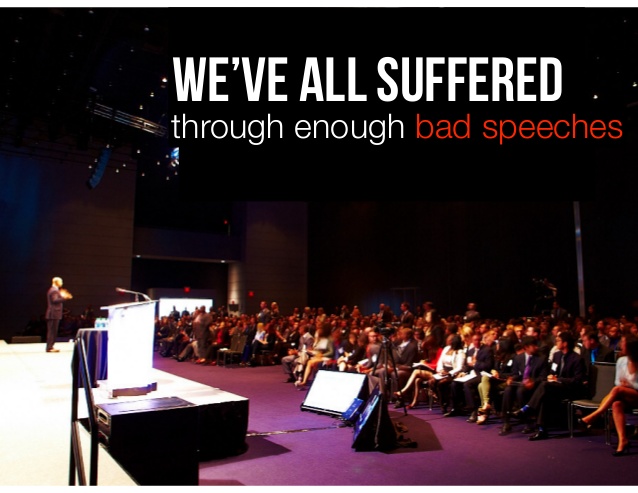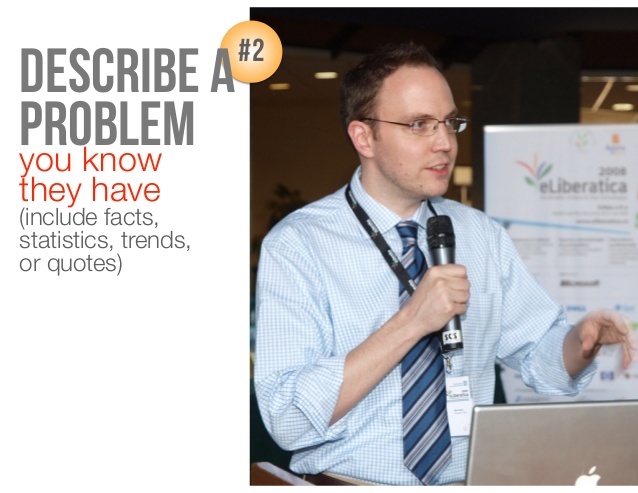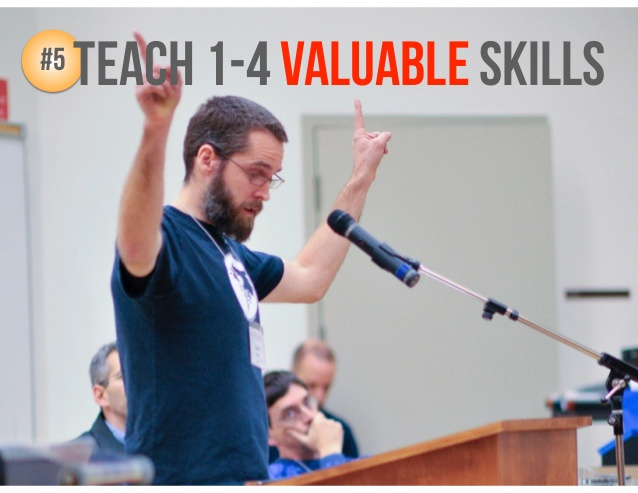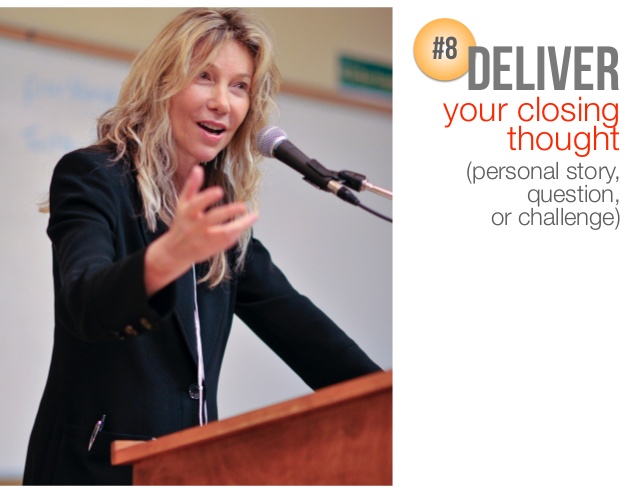How To Design A Great Speech
I admit it, I’m a slow learner. I would give a speech, thank the audience, talk with the event planner, and feel pretty good about my performance. But I wasn’t learning anything.
It wasn’t until I got a few, ahem, not-so-great responses from audiences that I woke up and remembered designing and delivering a great speech is work. And I wasn’t working hard enough.
Now, after delivering over 2,000 speeches, facilitated planning events, and seminars I’m fascinated by what works when presenting to an audience.
In this post I will share my eight-step template for designing a great speech. In full disclosure, I’ve freely borrowed and modified this over the years from people much smarter than me.
The Slideshare I posted on this topic is included below (you’re welcome). If you'd like a bit more detailed version, scroll down.
>> Watch for a second post coming soon on how to present a great speech. <<
WHEN YOU NEED THIS
Delivering a speech doesn’t just mean standing on stage with a microphone. It could also be: a team update, sales pitch, keynote speech, concurrent session at a conference, or inspiring your team of 13 year-old softball players.
Your goal is to inspire (get them to pay attention and take this seriously), inform (teach them something they need to know to be better), and motivate (get them to take action).That’s why you need a template. You message will be better received (emotional and logical brain) and more likely to move people to action if it’s organized. Plus, it saves you a ton of time as you put together the presentation.
MOST SPEECHES ARE HORRIBLE
 Let’s face it, not everyone can present like Bill Clinton, Oprah, or the late Randy Pausch. Most speeches are boring, poorly organized, irrelevant to the audience, and supported with horrible 12 pt-Time New Roman-undecipherable, redundant Powerpoint slides.
Let’s face it, not everyone can present like Bill Clinton, Oprah, or the late Randy Pausch. Most speeches are boring, poorly organized, irrelevant to the audience, and supported with horrible 12 pt-Time New Roman-undecipherable, redundant Powerpoint slides.
You can do better.When it comes to preparing for a speech, here are a few of the rules I live by:
- Less is better. They won’t know what’s missing and dropping 10% of your material gives you breathing room to ad lib and expand on a point, plus means you can more easily end on time (a huge plus in the eyes of event planners).
- Humour and a good story always trump more facts.
- Don’t make them look at the screen, you are the show. Less slides and way less stuff on slides is best. Check of the indispensable Presentation Zen by Garr Reynolds to be inspired to clean up your slides.
- Nobody will listen to you if they don’t first trust you. That’s what the first 10-20% of your time is for.
- Nobody cares what you know, until they know you care. That’s why you prove you know their problem.
BE A COLLECTOR OF CONTENT
I always recommend Evernote for storing and organizing all your stories, facts, statistics, anecdotes, quotations, frameworks, and models. The more content you have the easier it is to create a great speech on the fly.
THE 8-PART TEMPLATE THAT WILL SAVE YOU
I have coached dozens of other speakers and hands-down the template I’m sharing can repair even a bad speech.
#1 A SHORT OPENING
Your goal is to connect, build trust, and get them to lean in and listen. Start with a story (make it relevant), bold claim (“Imagine if the next 60 minutes could change your life…”), or good-old-humour. Please, no jokes about hotels, airplanes, or taxis - it signals that you are not like them (and don’t have a life.)
 #2 DESCRIBE A PROBLEM
#2 DESCRIBE A PROBLEM
This is critical. Remember: nobody cares what you know, until they know you care. Give them facts, trends, or quotes, but make it clear you have done your research and understand their pain. For most of my speeches, I describe the Age of Distraction and how downsizing, longer work hours, 24/7 communication, longer commutes, and smart phones have impacted our work and lives.
#3 SHARE YOUR STORY
If they don’t trust you yet, now they will. Tell them how you have been there, figured out a solution, and now you want to share that solution. The speaker coach, Craig Valentine calls this “Then, Now, How.” In a pinch you can also use a client story, or as a distant third choice, a story about someone else (please don’t use Mother Teresa, Nelson Mandela, Ben Franklin, Thomas Edison, the Wright Brothers, or Steve Jobs - you can be more creative then that).
#4 PRESENT A NEW APPROACH
My mother used to say: “Nothing is new under the sun.” Fine, but you still need to prove your worth, so it’s time to declare you have figured something out and it’s worth listening to. This is when I present my Think, Plan, Act model. No specific solutions yet, this is a heads-up outline of the good stuff about to come.
 #5 TEACH 1-4 VALUABLE SKILLS
#5 TEACH 1-4 VALUABLE SKILLS
You may have written the next “7 habits”, or have a 32 points about creating great Powerpoint slides (which is a bit ironic), but don’t present them all.
Audiences tend to have the attention of gnats, or less. I know that in 60 minutes, one to four really good, relevant, applicable lessons, points, solutions, tips, what-have-you is enough (remember: people won’t miss what isn’t there.)
#6 SUMMARIZE
This is when you look smart and start driving them to action. Summarize what you covered (always give quick examples how to use this in their life/work/family/synagogue) and, if you have time, get them to share their plans with a partner.
#7 MOTIVATE THEM TO TAKE ACTION
Speeches are about taking action. Don’t leave them all jacked up with great solutions, you need to get them off their self-doubts and do something. This is when I tell a success story from a client. I want the audience to envision how good it will feel to take action.
 #8 DELIVER YOUR CLOSING THOUGHT
#8 DELIVER YOUR CLOSING THOUGHT
Just like your opening, your closing thought should be scripted and rehearsed. The psychological principles (now don’t I sound smart?) of primacy and recency tell us people tend to remember the start and end of a speech (movies are good examples of this). I usually close with a challenge to the audience and a quotation.
There you go: a template you can use over and over to organize your thoughts and create better speech, faster.Here’s my closing thought…The reality is that audiences are poor learners. They are distracted, by the person next to them, the temperature of the room, the shoes you are wearing, and their need to go pee. Your job (unless you are a university professor, in which case all bets are off) is to move them to action. More content won’t do that.Design a better speech that appeals to the emotional brain and you might get lucky and get their logical brain to take action.Hope that helps. Leave me a comment below and tell me if you can use this.
Small Wins - Why Little Steps are the Path to Big Rewards
Keynotes and workshops by Hugh Culver


